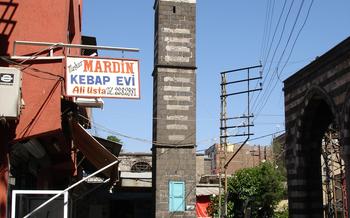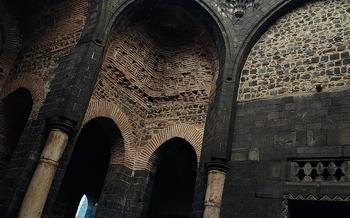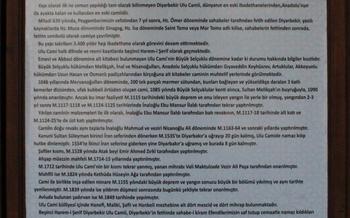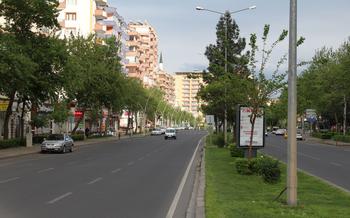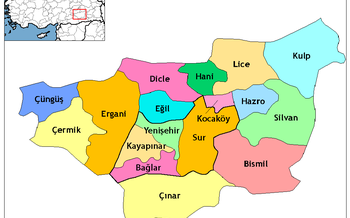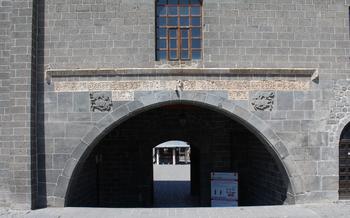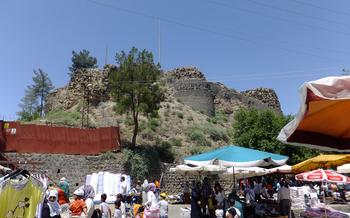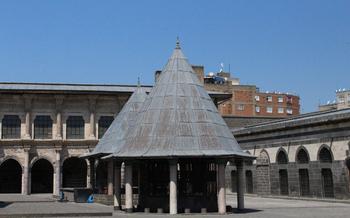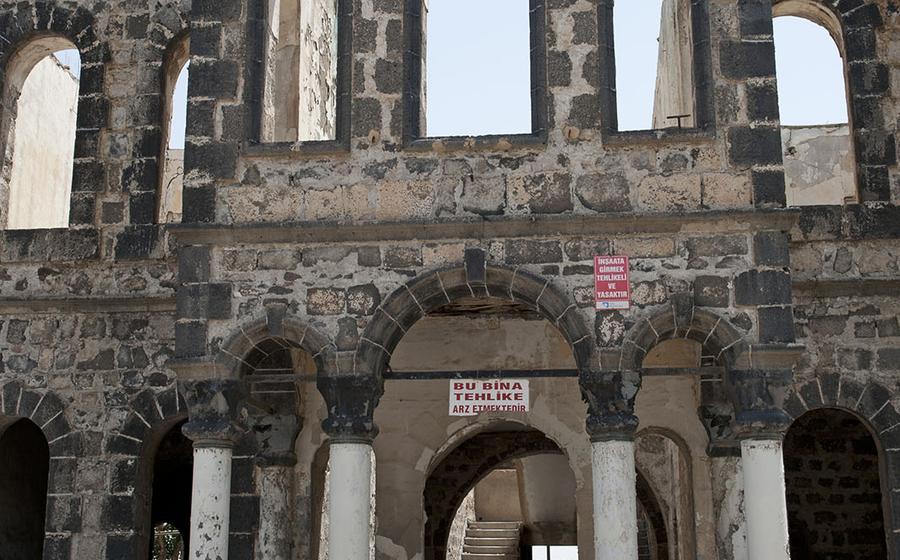
Diyarbakır City Museum
- History of Diyarbakır City Museum:
- Location and Accessibility
- Public Transportation
- Private Vehicles
- Navigating the Area
- Exhibitions and Collections
- Archaeological Treasures
- Islamic and Ottoman Art
- Temporary Exhibitions
- Educational Programs
- Guided Tours
- Accessibility for Visitors with Disabilities
- Museum Store and Souvenirs
- Surrounding Attractions
- Local Cuisine and Dining Options
- Photography and Social Media
- Insider Tip
History of Diyarbakır City Museum:
Diyarbakır City Museum stands as a proud testament to the rich cultural heritage of southeastern Turkey. Its journey began in the early 20th century when the need for a dedicated space to preserve and showcase the region's historical artifacts became apparent. In 1935, the museum's doors opened to the public, housing a diverse collection that spanned various eras and civilizations.
The museum's establishment was a significant milestone in the preservation of Diyarbakır's cultural legacy. It played a pivotal role in safeguarding the city's unique identity amidst the tumultuous political and social changes of the 20th century. The museum's commitment to preserving and presenting the region's cultural heritage has earned it a prominent position among Turkey's leading cultural institutions.
The architectural style of the museum building reflects a harmonious blend of traditional and modern elements. Its imposing facade, adorned with intricate carvings and decorative motifs, pays homage to the region's rich architectural heritage. Inside, the museum's spacious galleries and well-curated exhibits provide a welcoming and educational environment for visitors to explore the diverse cultural tapestry of Diyarbakır.
The establishment of the Diyarbakır City Museum is not without its fascinating anecdotes. One such story tells of a group of dedicated individuals who tirelessly scoured the region, collecting artifacts from remote villages and historical sites. Their efforts ensured that precious pieces of Diyarbakır's history were preserved for future generations.
Location and Accessibility
The Diyarbakır City Museum is strategically positioned in the heart of Diyarbakır, a city steeped in history and culture. Its exact address is Diyarbakır Kalesi İçi, 21100 Sur/Diyarbakır, Turkey. Reaching the museum is a breeze, whether you prefer public transportation or the convenience of your private vehicle.
Public Transportation
For those relying on public transportation, the museum is easily accessible via local buses. Simply hop on any bus that stops at the Diyarbakır Kalesi bus stop, and you'll find yourself just a short stroll from the museum's entrance.
Private Vehicles
If you prefer the flexibility of your own car, the museum offers ample parking facilities for visitors. Designated parking spaces are available within the museum complex, ensuring a hassle-free parking experience.
Navigating the Area
Once you arrive at the museum, you'll find yourself surrounded by a vibrant neighborhood brimming with historical landmarks and cultural attractions. Take advantage of this opportunity to explore the city's rich heritage by visiting nearby sites like the iconic Diyarbakır Fortress or the impressive Ulu Mosque.
Exhibitions and Collections
The Diyarbakır City Museum houses a diverse collection of artifacts, documents, and artworks that provide a comprehensive overview of the region's rich history and cultural heritage. The museum's permanent exhibitions are organized into thematic sections, each focusing on a specific aspect of Diyarbakır's past. The Islamic and Ottoman Art section showcases exquisite examples of calligraphy, tilework, ceramics, and textiles, highlighting the region's artistic achievements during these periods. Another section is dedicated to archaeological findings, displaying artifacts from Neolithic settlements, ancient civilizations such as the Assyrians and Romans, and the Islamic era. Visitors can also explore galleries dedicated to folklore and ethnography, which showcase traditional costumes, handicrafts, and everyday objects, offering insights into the daily life and customs of local communities. Interactive displays and educational programs enhance the visitor experience, making the Diyarbakır City Museum an ideal destination for history enthusiasts, culture seekers, and anyone interested in exploring the diverse heritage of this ancient city.
Archaeological Treasures
The Diyarbakır City Museum houses a rich collection of archaeological treasures that shed light on the ancient civilizations and cultures of the region. Highlights include artifacts from the Neolithic period, such as intricately carved stone tools and pottery, offering a glimpse into the earliest human settlements in the area.
Among the most significant archaeological finds is a collection of cuneiform tablets dating back to the 3rd millennium BC. These tablets, inscribed with Akkadian and Sumerian script, provide valuable insights into the history, language, and social structures of ancient Mesopotamia.
The museum also boasts a remarkable collection of Urartian artifacts, including bronze sculptures, jewelry, and ceramics. These artifacts showcase the artistic prowess and cultural achievements of the Urartian civilization, which flourished in the region during the 9th to 6th centuries BC.
Another highlight of the museum's archaeological collection is a series of impressive stone reliefs from the Neo-Hittite period (11th to 8th centuries BC). These reliefs depict scenes of warfare, hunting, and religious ceremonies, offering a glimpse into the military prowess and cultural practices of the Neo-Hittite kingdoms.
These archaeological treasures, meticulously preserved and displayed in the Diyarbakır City Museum, provide visitors with a tangible connection to the rich and storied past of this ancient land. Each artifact tells a tale of human ingenuity, cultural exchange, and the rise and fall of civilizations, making the museum a must-visit destination for anyone interested in the history and archaeology of the region.
Islamic and Ottoman Art
The Diyarbakır City Museum also houses an impressive collection of Islamic and Ottoman art, showcasing the rich cultural heritage of the region. Visitors can admire exquisite examples of calligraphy, the art of beautiful handwriting, which holds a revered position in Islamic culture. The museum displays intricate manuscripts adorned with elegant script, offering a glimpse into the mastery of this art form.
Tilework, another prominent feature of Islamic architecture, is well-represented in the museum's collection. Visitors can marvel at the vibrant colors and intricate geometric patterns that adorn these ceramic tiles, which were used to decorate mosques, palaces, and other significant buildings. The museum also exhibits a range of ceramics, including pottery and porcelain, showcasing the region's skilled craftsmanship and artistic traditions.
Textiles, with their vibrant colors and intricate designs, play a significant role in Islamic and Ottoman art. The museum's collection includes finely woven carpets, embroideries, and traditional costumes, demonstrating the region's rich textile heritage. These textiles not only served a functional purpose but also held cultural and symbolic significance, representing the creativity and artistry of local artisans.
Temporary Exhibitions
The Diyarbakır City Museum also hosts a variety of temporary exhibitions throughout the year, showcasing a diverse range of themes, artists, and historical periods. These exhibitions provide visitors with an opportunity to explore new perspectives and engage with contemporary artistic expressions.
Past exhibitions have delved into topics such as the history of photography in Diyarbakır, the works of local contemporary artists, and the cultural heritage of neighboring regions. The museum collaborates with local and international institutions to bring these exhibitions to life, ensuring a dynamic and ever-changing display.
Special events, workshops, and guided tours often accompany temporary exhibitions, offering visitors a deeper understanding of the featured themes. These events provide a platform for artists, historians, and cultural enthusiasts to share their knowledge and insights with the public.
To make the most of your visit during a temporary exhibition, it is advisable to check the museum's website or social media pages for up-to-date information on current and upcoming shows. Planning your visit in advance will allow you to tailor your experience and fully immerse yourself in the featured content.
Educational Programs
The Diyarbakır City Museum offers a range of educational programs designed to engage visitors of all ages with the museum's collection and history. These programs include workshops, lectures, and interactive activities that cater to both children and adults.
Workshops: The museum regularly organizes workshops on various topics related to its collection, such as traditional crafts, archaeology, and Islamic art. These workshops provide participants with hands-on experience and insights into the region's cultural heritage.
Lectures: The museum hosts lectures by renowned scholars, historians, and archaeologists who share their expertise on topics related to Diyarbakır's history, culture, and archaeology. These lectures offer visitors an opportunity to learn from experts and engage in discussions on various aspects of the region's past.
Interactive Activities: The museum features interactive displays and educational programs that make learning fun and engaging for children. These activities include quizzes, games, and multimedia presentations that help children explore the museum's collection in a hands-on manner.
School Groups: The museum welcomes school groups and offers guided tours tailored to their specific curriculum needs. These tours provide students with a comprehensive overview of the museum's collection and history, enhancing their understanding of the region's cultural heritage.
Research Opportunities: The museum's collection and resources are available to researchers and scholars who wish to conduct research on various aspects of Diyarbakır's history and culture. The museum provides access to its archives, library, and artifacts for qualified researchers.
Success Stories: The museum's educational programs have been highly successful in engaging the community and promoting cultural awareness. One notable example is the "Young Archaeologists" program, which has inspired many young people to pursue careers in archaeology and heritage preservation.
Guided Tours
The Diyarbakır City Museum offers guided tours in multiple languages, including English, Turkish, and Arabic, to enhance the visitor experience. These tours provide a deeper understanding of the museum's history, collections, and highlights, allowing visitors to appreciate the cultural significance of the artifacts on display. Knowledgeable guides share captivating stories and insights, bringing the exhibits to life.
Booking a guided tour is highly recommended, especially for first-time visitors or those seeking a more comprehensive exploration of the museum. Reservations can be made in advance online or at the museum's information desk. Guided tours typically last for about an hour and a half, allowing ample time to cover the main exhibitions and learn about the museum's unique treasures.
To make the most of your guided tour, arrive at the museum a few minutes early to ensure a prompt start. Be sure to wear comfortable shoes as there will be a fair amount of walking involved. Don't hesitate to ask your guide questions or request further information on specific exhibits that pique your interest.
Whether you're a history buff, an art enthusiast, or simply someone curious about the rich cultural heritage of Diyarbakır, a guided tour of the Diyarbakır City Museum is an enriching and memorable experience that should not be missed.
Accessibility for Visitors with Disabilities
The Diyarbakır City Museum is committed to providing an inclusive and welcoming environment for all visitors, regardless of their abilities. Accessibility features have been carefully considered to ensure that everyone can enjoy and learn from the museum's collections and exhibitions.
Visitors with disabilities will find ramp access and elevators throughout the museum, making all levels easily accessible. Designated parking spaces are available close to the entrance for those arriving by private vehicle.
For those who require assistance, wheelchairs are available on request at the museum's information desk. Audio guides are also available in multiple languages, providing a rich and informative experience for visitors with hearing impairments. For visitors who are deaf or hard of hearing, sign language interpreters can be arranged with advance notice.
The museum's staff is trained to be attentive and supportive of visitors with disabilities. They are always willing to provide assistance or answer any questions to ensure a smooth and enjoyable visit.
By prioritizing accessibility, the Diyarbakır City Museum demonstrates its commitment to creating an inclusive space where everyone can engage with and appreciate the rich cultural heritage of the region.
Museum Store and Souvenirs
The Diyarbakır City Museum gift shop is an extension of the museum's mission to preserve and promote cultural heritage. It offers a unique selection of souvenirs, replicas, and educational materials that allow visitors to take a piece of their museum experience home.
From intricately designed replicas of ancient artifacts to traditional textiles and handicrafts, the museum store has something for every taste and budget. Local artisans create many of the products, ensuring that visitors not only support the museum but also the local community.
A visit to the museum store is an excellent opportunity to find unique souvenirs that will remind you of your time in Diyarbakır. Whether you choose a hand-painted ceramic plate, a traditional Kurdish rug, or a book on the region's history, your purchase will help support the museum's ongoing work to preserve and protect Diyarbakır's cultural heritage.
Insider Tip: Keep an eye out for limited-edition items and seasonal collections that showcase the work of local artists and artisans. These unique pieces make excellent gifts or keepsakes for those who appreciate handmade and locally crafted goods.
Surrounding Attractions
Enrich your Diyarbakır experience by exploring the city's vibrant tapestry of historical, cultural, and natural attractions. A short stroll from the Diyarbakır City Museum, you'll find the iconic Diyarbakır Fortress, a UNESCO World Heritage Site. Gaze upon its imposing walls and towers, remnants of a glorious past. Step inside to wander through its atmospheric streets, lined with traditional houses and shops, and soak in the city's rich history.
For a serene escape, head to the picturesque Dicle River, which meanders through Diyarbakır. Take a leisurely walk along its banks, admiring the stunning views of the city skyline. Cross the iconic Dicle Bridge for panoramic vistas of the river and the surrounding landscape.
Delve deeper into the region's past at the Diyarbakır Archaeological Museum, home to an impressive collection of artifacts from various civilizations that have graced this land. Discover ancient treasures, including pottery, jewelry, and sculptures, that tell the story of Diyarbakır's rich cultural heritage.
To experience the spiritual side of Diyarbakır, visit the magnificent Grand Mosque, a architectural marvel that ranks among the largest mosques in Turkey. Admire its intricate tilework, soaring minarets, and serene courtyard. Immerse yourself in the tranquility of this sacred space and witness the vibrant tapestry of Islamic architecture.
For a glimpse into the city's vibrant contemporary culture, explore the bustling streets of Diyarbakır's modern neighborhoods. Discover charming boutiques, art galleries, and lively cafes, where you can indulge in local delicacies and engage with the friendly locals.
Plan a comprehensive itinerary that allows you to seamlessly blend a visit to the Diyarbakır City Museum with these captivating attractions. Experience the harmonious fusion of history, culture, and modernity that defines this vibrant city.
Local Cuisine and Dining Options
A visit to Diyarbakır is incomplete without savoring the city's delectable cuisine. Diyarbakır's culinary heritage is a blend of Turkish, Kurdish, and Armenian influences, resulting in a diverse array of flavors and dishes.
For an authentic experience, head to one of the many local restaurants near the museum. Try traditional dishes like "mırra," a hearty lamb stew flavored with aromatic spices, or "kaburga dolması," tender lamb ribs stuffed with rice and herbs. Don't miss the famous "çiğ köfte," a spicy raw meatball dish that is a local specialty.
Vegetarians will find plenty of options, too. Sample "kısır," a bulgur-based salad with fresh herbs and vegetables, or "imam bayıldı," roasted eggplants stuffed with a flavorful mixture of onions, garlic, and tomatoes.
Be sure to accompany your meal with a glass of ayran, a refreshing yogurt drink, or şalgam suyu, a unique fermented turnip juice that is a local favorite.
For dessert, indulge in "kadayıf," a crispy shredded wheat pastry filled with nuts and sweetened with syrup, or "künefe," a cheese-filled pastry topped with shredded wheat and syrup.
Remember, Diyarbakır's cuisine is known for its generous portions, so come with an appetite or be prepared to share. Enjoy the vibrant food culture and culinary delights that this city has to offer.
Photography and Social Media
The Diyarbakır City Museum encourages visitors to capture their experiences and share them with the world. Photography is allowed in most areas of the museum, but visitors are kindly requested to respect the privacy of other visitors and the integrity of the exhibits. Using flash photography or tripods is not permitted.
When sharing your photos and experiences on social media, be sure to tag the museum and use relevant hashtags. This helps promote the museum and allows others to discover its treasures. Be creative with your captions and share your insights and impressions of the exhibits. Remember to follow the museum's social media channels for updates on new exhibitions, events, and behind-the-scenes content.
Insider Tip
As an avid museum-goer, I stumbled upon a hidden gem within the Diyarbakır City Museum. Tucked away in a secluded corner of the archaeological section, I discovered an unassuming display of ancient jewelry. Among the intricate necklaces and earrings, a delicate gold pendant caught my eye. The intricate filigree and the shimmering gemstones captivated me. Upon closer examination, I learned that this pendant was believed to be part of a bridal set from the 13th century. It was a rare and exquisite artifact that spoke volumes about the artistry and craftsmanship of that era. This hidden treasure made my visit to the museum truly unforgettable.

